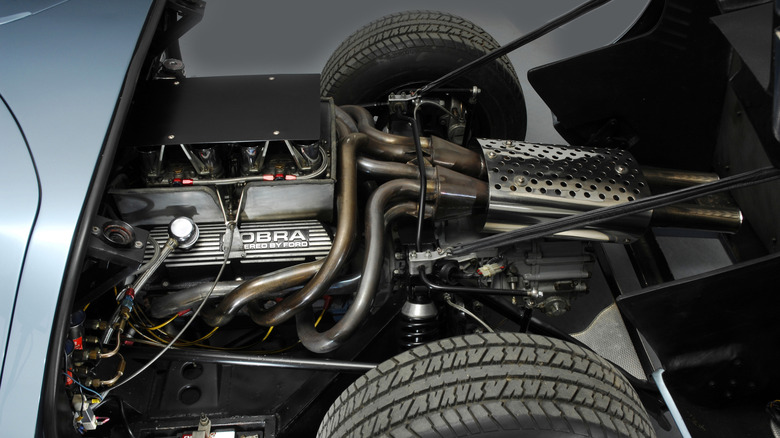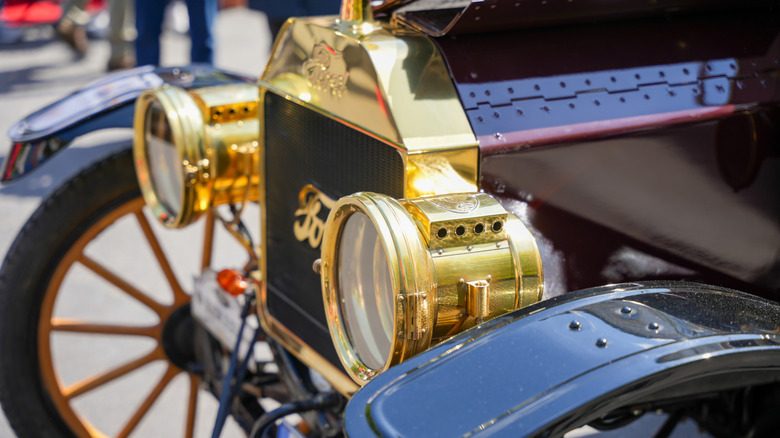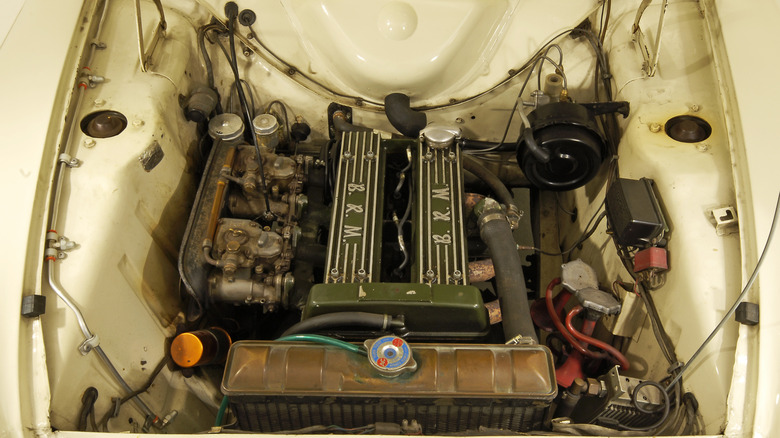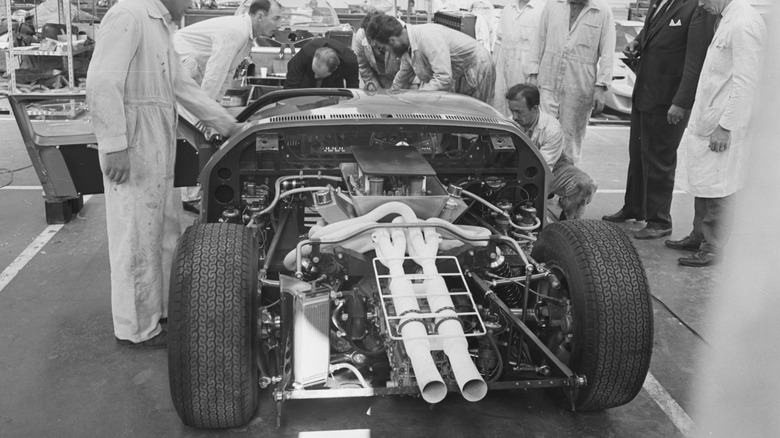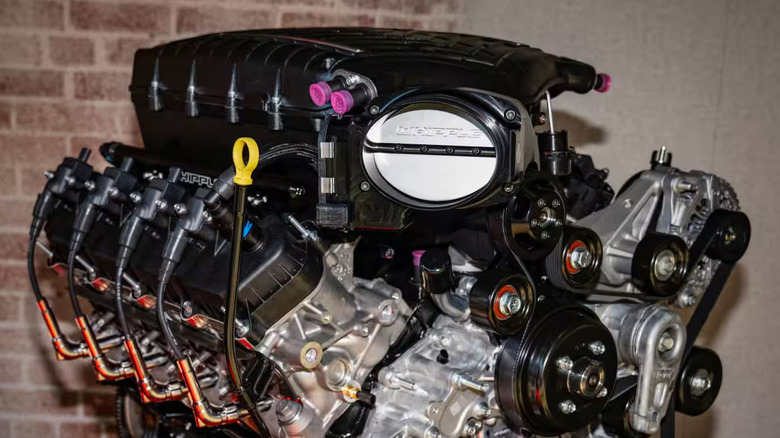5 Of The Best Engines To Ever Power A Ford
Ford is one of the few brands still alive and kicking that spans from the very earlier days of motoring. Founded in 1903, the blue oval brand boasts a 122-year history of automobile manufacturing, and throughout those many decades Ford has achieved some mighty accomplishments. From impressing at touring car events, to producing fistfuls of collectible muscle cars, and even taking glory from the Italians on one of the most global motorsport stages of all time, Ford has long been at the forefront.
Sleek designs and talented racers have been crucial to this success, but so have the many engines churned out by Ford's evidently talented engineers. Without a capable engine, the Ford Model T might've been a commercial flop, and the GT40 could have simply been a pretty sports car from days long-gone. However, time after time Ford got its engine recipes down right, and we've decided to celebrate some of the most iconic engines here. As a lifelong Ford enthusiast and having been at the helm of some cars powered by the historically important engines below, I feel I can pass judgement on what makes them the greatest of all time. However, whittling down this list has not been an easy task, and no doubt many favorites have been missed — such is the expansiveness of Ford's engine backcatalog. Let's dive into the best of the best, and work through them chronologically.
The Ford Model T's inline-four
Our journey through Ford's greatest ever engines starts with the humble Model T. This engine is not great in the sense that it was hugely technical at the time, or powerful, or efficient, or really anything other than just ordinary. But that's the key; Ford created a wonderfully ordinary engine that could perform everyday tasks without constant hiccup and worry for the owner. Perhaps this was the key to the Model T's monstrous success, with more than 15 million examples finding new owners before production ended in 1927.
Of those 15 million, all sported the same 2.9-liter inline-four, which was remarkably simple and easy to work on. It was the first of its kind to boast a removable cylinder head, which made carrying out work on the unit much easier in comparison to some other engines from the period. For anyone wondering how powerful the Ford Model T engine is, the inline-four kicked out around 20 horsepower, and 83 lb-ft of torque, which was enough to see it achieve a top speed of roughly 35 mph — maybe 40 mph at a stretch.
So, the Model T's inline-four is one of the greatest simply because it got the world moving — a feat which automakers had been struggling to achieve for some years prior. Another engine worthy of note for this same reason would be the blue oval's flathead V8. This popular V8 really got the masses motoring during the 1930s and beyond, and proved that Ford could master that difficult second album.
Ford joined forces with Lotus to produce this iconic twin-cam
This next engine bears more than just that iconic blue Ford badge, as it was developed in conjunction with Lotus. In the 1960s, Ford decided to go saloon-car racing — or touring car racing — and so a hot sedan was in order. Ford opted to go with the Cortina; a new model at the time that fit the bill perfectly, except it needed more grunt.
Ford called in the help of Lotus, who were already a proven entity when it came to producing excellent drivers' cars, and so an excellent fit. Between the two automakers, the Lotus-Ford Twin-Cam engine was crafted. Ford supplied the bottom end, a simple 1.6-liter lump, which would produce up to 150 horsepower when mated with the trick cylinder head Lotus put together for the project. Road-going models sported an output of around 105 horses, but those higher-HP racers went on to really impress on the track, racking up numerous wins across the years in both first- and second-generation Lotus Cortina models. In the U.S., Alan Mann Racing won the European Saloon Car Championship in '65 with one such Cortina, while in '66 the RAC Rally was won by another. This success would continue for many years, with victories on tarmac and the rough stuff coming the Lotus-Ford-powered Cortina's way.
This engine proved you didn't need a high-capacity sports car to impress, and the point was driven home twice as hard when equipped under the hoods of Colin Chapman's immensely simple and lightweight Lotus Seven models throughout the same decade. Put simply, the Lotus-Ford Twin-Cam engine was a lesson in precision and it remains a hallmark of British engineering today.
Ford's 427 V8 took on Ferrari, and won
Sometimes, though, instead of tweaking a small-capacity inline-four, you really do need to listen to that old adage; "There's no replacement for displacement!". By now, if you're at all into cars and motorsport, you'll be familiar with the story of Ford taking on Ferrari at Le Mans and walking away victorious with four wins on the trot in the mid-1960s. If not, check out "Ford v Ferrari," which documents the history behind one of motorsport's greatest ever triumphs.
In a nutshell, Ford wanted to buy Ferrari, Ferrari instead turned to Fiat, and Ford sought revenge by taking them on at Le Mans with the now insanely desirable and collectible Ford GT40. Few race cars can boast such global recognition, and few engines can boast such awesome success either, winning time and time again at an endurance race which saw now 60-year-old designs running at full chat for 24 hours each. There's simply no way the 427ci V8 lump that powered these beastly race cars could ever be omitted from a list such as this one.
Just a brief overview of the numbers is enough to demonstrate the awesomeness of this V8; seven liters, 210 mph, 485 brake horsepower, 475 lb-ft of torque, and four consecutive victories at Le Mans.
This 7.0-liter V8 was the BOSS of the muscle car era
Muscle cars play a huge part of Ford's history, so what's the muscliest muscle car out there with a Ford badge on the front? The Boss 429 puts up a strong argument for itself, with 7.0 liters of all-American grunt producing a factory-rated 375 horsepower – although many insist the real figure was somewhat north of this. The Boss Mustang also boasts real racing pedigree, too, having shown everyone how to do business in NASCAR throughout the '69 season, in addition to standing out on the streets also, as one of Ford's last true muscle cars before the '73 oil crisis stopped all the fun.
Part of what made the Ford Mustang Boss 429 special was the engineering that went into this huge engine, and the drivetrain as a whole. Unlike anything else from Ford's engine backcatalog at the time, this 7.0-liter V8 used hemispherical "crescent" combustion chambers, much like the engines from Dodge's best muscle efforts of the era. Ford also used aluminum cylinder heads, which featured separate cooling circuits, allowing for improved cooling. From here, the engine was then hooked up to a close-ratio four-speed manual transmission, with a rear limited-slip differential thrown in for good measure. This was a muscle car with real racing pedigree, and with just over 1,350 made, it's a real legend of the era.
The Megazilla 2.0 proves that Ford still knows how to produce awesome engines
It's true that many awesome Ford engines hail from decades long gone. That doesn't mean that more modern efforts are any lesser — but to call them the "best ever" seems like a stretch, especially when it means knocking one of the classic greats off the list. However, one modern engine from Ford definitely deserves a mention here, and it's the 1,000-horsepower Megazilla 2.0 crate engine.
The original Megazilla was impressive in its own right, churning out 612 horsepower from a naturally aspirated 7.3-liter V8, but when Ford strapped on a Gen 6 3.0-Liter Whipple supercharger, the engine was transformed into something that really stands out as one of the greats. It manages to challenge the output of Chevrolet's ZZ632 crate engine, with three fewer liters, and boasts an immensely impressive spec list too. The pistons and connecting rods are forged; there's a steel crank; ported and polished cylinder heads; plus upgraded valve springs in there too. Sure, it's for competition use only, but for when it comes to creating a blue-oval-badged project, this is surely the ultimate crate engine to opt for. As the world continually leans closer to an electrical or at least hybridized takeover, engines like this make less sense to exist, so we may be looking at one of the last truly great ICE offerings from Ford here, and that makes it well worth a spot on this list.
